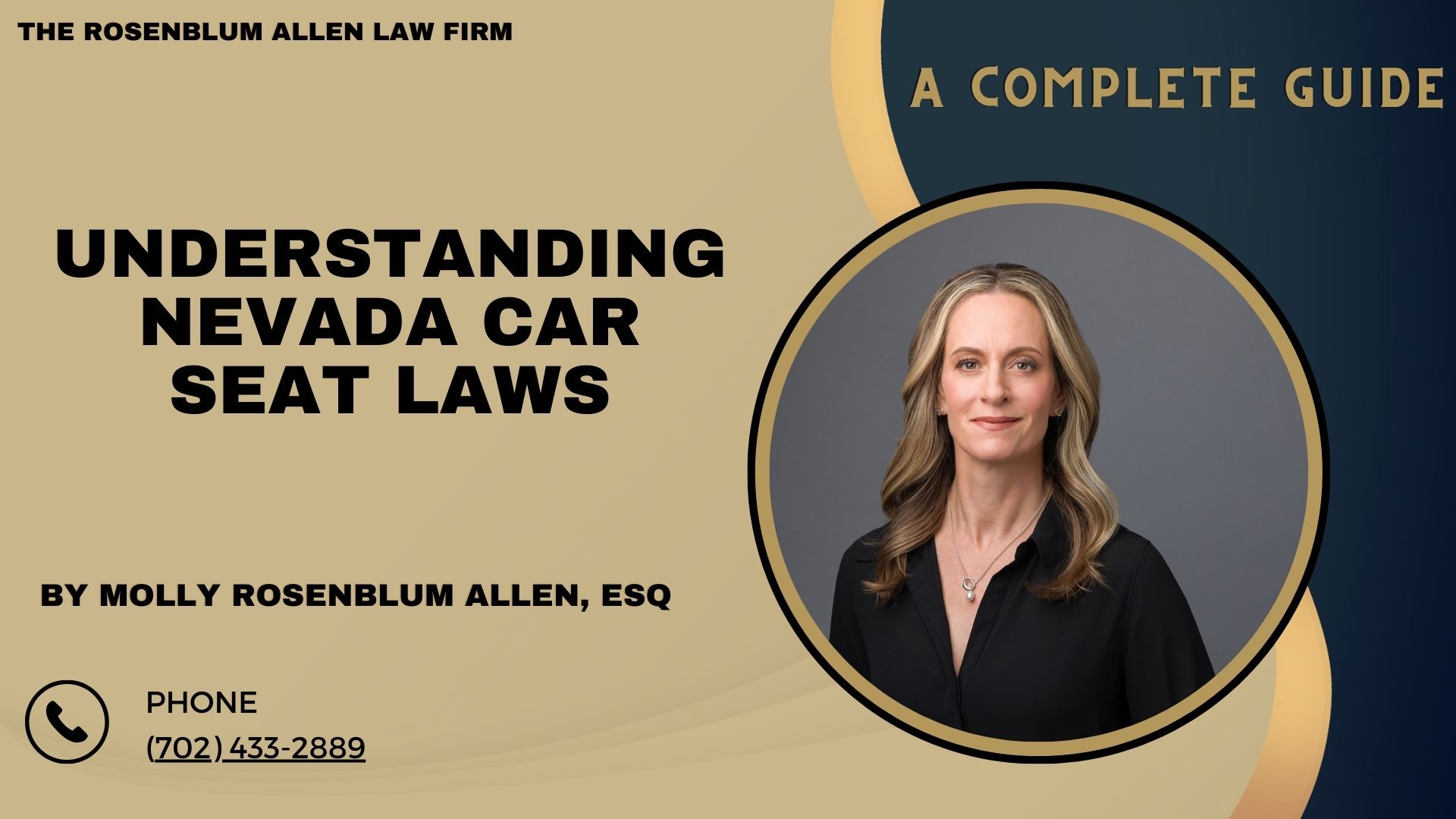Keeping your child safe in the car is more than just a priority—it’s the law. Nevada has specific car seat laws designed to protect children in case of accidents. If you’re a parent or caregiver in Nevada, it’s essential to know these laws and how to choose and install the right car seat for your child.
In this guide, we’ll break down Nevada’s car seat regulations so you can ensure your child is traveling safely and legally.
 \Nevada Car Seat Laws Overview
\Nevada Car Seat Laws Overview
Nevada law requires that all children under six weighing less than 60 pounds be secured in an appropriate child restraint system. Depending on the child’s age, weight, and height, this could be a rear-facing car seat, a forward-facing car seat, or a booster seat.
The law aims to protect children by ensuring that they are appropriately restrained in case of an accident. Failure to comply can lead to fines and other penalties, which we’ll cover later.
Important Points to Remember:
- Children under six years old and weighing under 60 lbs must be in a child safety seat.
- The type of seat varies based on age, weight, and height.
- Seat belts alone are insufficient for children under these age and weight limits.
Car Seat Requirements for Infants and Toddlers
Choosing the right seat for infants and toddlers is crucial, as they are the most vulnerable passengers in a vehicle. Nevada law specifies that infants must ride in a rear-facing car seat until they reach a certain weight and age.
Rear-Facing Car Seats
Age and Weight Guidelines for Rear-Facing Seats
- Infants under one year old must ride in a rear-facing car seat.
- Nevada law recommends that infants remain rear-facing until they weigh at least 20 lbs or as per the manufacturer’s guidelines.
Rear-facing seats provide the best protection for an infant’s head, neck, and spine. It is safest for children to remain rear-facing as long as possible, even after their first birthday, provided they have not exceeded the seat’s weight limit.
Transitioning to Forward-Facing Car Seats
- Once a child exceeds 20 lbs and is at least one year old, they can transition to a forward-facing seat. However, keeping a child rear-facing for longer provides better protection.
Installing Rear-Facing Car Seats
- Ensure the car seat is installed at the correct angle to prevent the baby’s head from flopping.
- Use the car seat’s harness to fasten the child securely.
- The harness straps should be at or below the child’s shoulders when rear-facing.
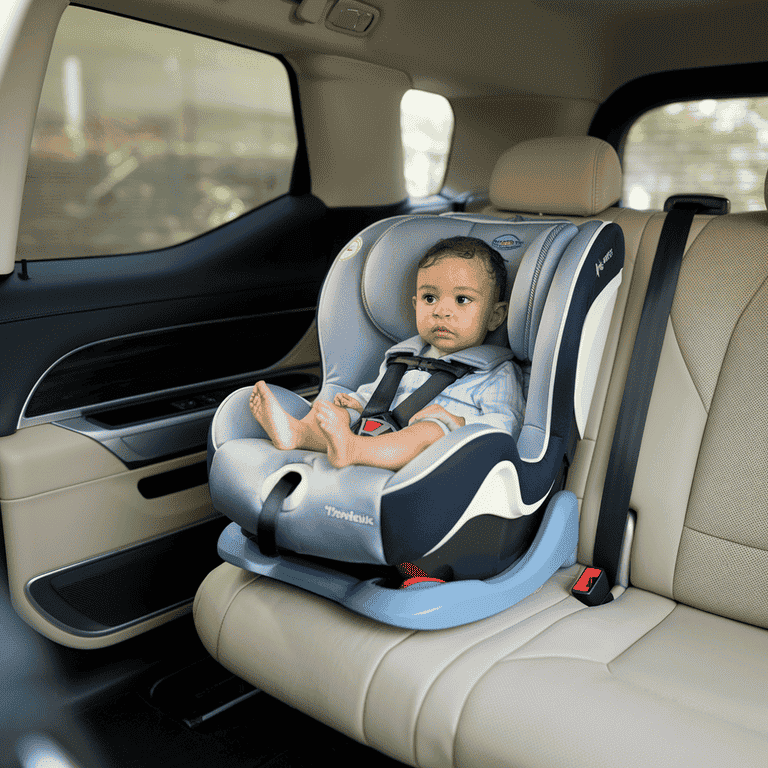
Forward-Facing Car Seat Regulations
As your child grows, it’s time to switch to a forward-facing car seat. Nevada law specifies that children must use an appropriate forward-facing seat until they meet the height and weight requirements for a booster seat.
Age and Weight Specifications for Forward-Facing Seats
- After one year and 20 lbs, children can sit in forward-facing car seats.
- Nevada recommends children remain in a forward-facing car seat with a harness system until they weigh 40 lbs.
Proper Installation of Forward-Facing Car Seats
A forward-facing car seat must be installed carefully to ensure your child’s safety.
Use of the Harness System
- Ensure the 5-point harness is snug, and the chest clip is at armpit level.
- The harness should fit tightly, allowing no more than a finger’s width between the straps and the child’s body.
Using the Tether Anchor for Safety
- Many forward-facing car seats come with a tether strap. Ensure this is attached to your car’s tether anchor for additional stability, reducing the risk of the seat tipping forward during a crash.
This section covers the basic requirements and installation tips for rear-facing and forward-facing car seats. Next, we’ll discuss booster seat regulations and when to switch.
Booster Seat Requirements in Nevada
Once your child outgrows their forward-facing car seat, it’s time to switch to a booster seat. Booster seats help position the seat belt correctly on a child’s body, providing the best protection in the event of an accident.
When to Switch from a Forward-Facing Car Seat to a Booster Seat
Transitioning from a forward-facing car seat to a booster seat usually happens when your child reaches 40 lbs or more. Nevada law requires children to use a booster seat until they meet specific height or age guidelines.
Here are some general signs that it’s time to switch:
- Height: If your child’s shoulders are above the top harness slots of the forward-facing seat, it’s time for a booster.
- Weight: When your child outgrows the weight limit of the forward-facing seat (usually 40 to 65 lbs, depending on the seat).
Types of Booster Seats
Booster seats come in two main types. Each serves the same purpose—lifting the child to ensure the seat belt fits correctly—but has different features.
Backless Boosters
- These are smaller and typically used when the vehicle’s seat provides head support.
- It is ideal for older children who don’t need extra back support.
High-Back Boosters
- Provide head and neck support, especially in cars without high backrests.
- It is helpful for younger children transitioning from a forward-facing seat.
Correct Use of Booster Seats
Proper use of a booster seat is key to keeping your child safe. Here’s what you need to know:
- The lap belt should lie flat across your child’s thighs, not their stomach.
- The shoulder belt should cross the middle of your child’s chest and shoulder, not their neck or face.
- Make sure your child sits back against the vehicle seat.
Booster seats should always be used in the back seat of the car. The front seat is dangerous for young children due to airbag deployment.
Seat Belt Requirements for Children
Eventually, your child will be ready to ditch the booster seat and use a regular seat belt. Nevada law sets specific guidelines to ensure children are ready for this important milestone.
When Can Children Use a Seat Belt Without a Booster?
In Nevada, a child can switch to using just a seat belt when:
- They are at least 4’9” tall (usually around eight years old).
- The seat belt fits them properly in terms of height and weight.
It’s important not to rush this transition. A seat belt that doesn’t fit properly can do more harm than good in an accident.
Seat Belt Fit Test
Before you let your child ride without a booster seat, use this simple test to ensure the seat belt fits correctly:
- Back against the seat: Can your child sit with their back fully against the vehicle’s seat?
- Knees bent at the edge: Do their knees bend naturally at the edge of the seat?
- Lap belt position: Does the lap belt lie flat across the thighs, not the stomach?
- Shoulder belt position: Does the shoulder belt sit across the chest and shoulder, not the neck?
If the answer to these questions is “no,” your child should continue using a booster seat for better safety.
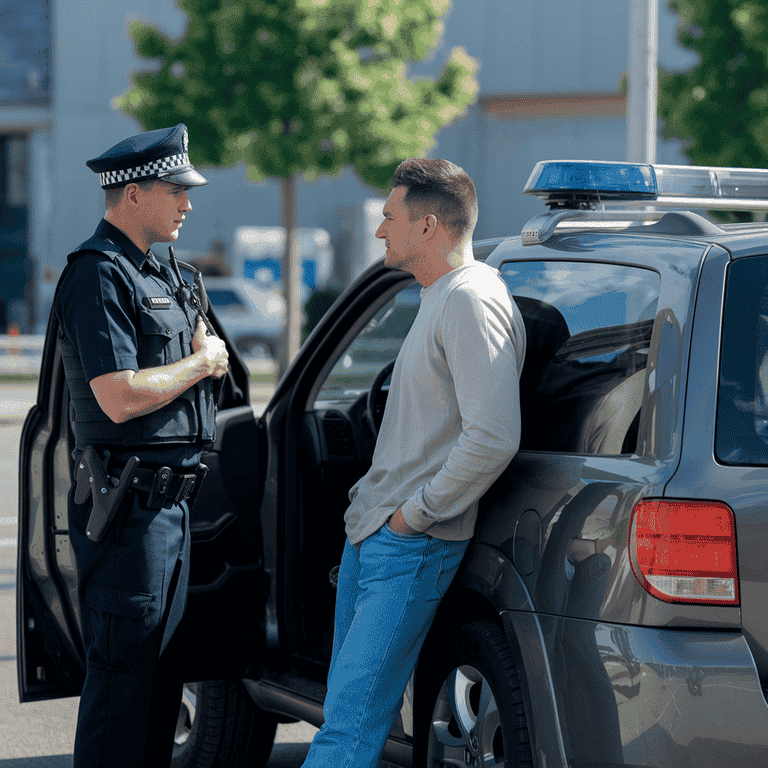
Penalties for Violating Nevada Car Seat Laws
Understanding the laws isn’t just about keeping your child safe—it’s also about avoiding penalties. Nevada takes car seat safety seriously, and failing to comply with the laws can result in fines.
Fines and Consequences for Violating Car Seat Regulations
If you’re caught violating Nevada’s car seat laws, here’s what you could face:
- First-time offenders: Fines can range from $100 to $500.
- Repeat offenses: The penalties can be harsher, with increasing fines and possible points added to your driving record.
Aside from fines, violating car seat laws puts your child at serious risk. Following these rules is essential for their safety.
Defensive Driving Classes
In some cases, attending a defensive driving class may reduce the fine or avoid points on your record. It’s always better to be proactive and ensure your car seat is installed and used correctly, but this could be a helpful option for first-time offenders.
Car Seat Installation and Inspection Services in Nevada
Even the best car seat will only protect your child if installed correctly. Studies show that many car seats are installed improperly, increasing the risk of crash injury.
Importance of Proper Installation
A properly installed car seat can be a lifesaver. Yet, it’s surprisingly easy to make mistakes when installing one. That’s why it’s a good idea to inspect your car seat by a professional to ensure it’s securely in place and adjusted for your child.
Free Car Seat Inspection Services
The good news is that Nevada offers free car seat installation and inspection services in many areas. Certified technicians can help ensure that your seat is correctly installed. You can find inspection services at:
- Police and fire departments: Many local stations offer free inspections.
- Hospitals: Some hospitals provide car seat checks, especially for newborns.
- Community centers: Local community centers may host car seat safety events.
Taking advantage of these services can give you peace of mind and ensure your child’s safety.
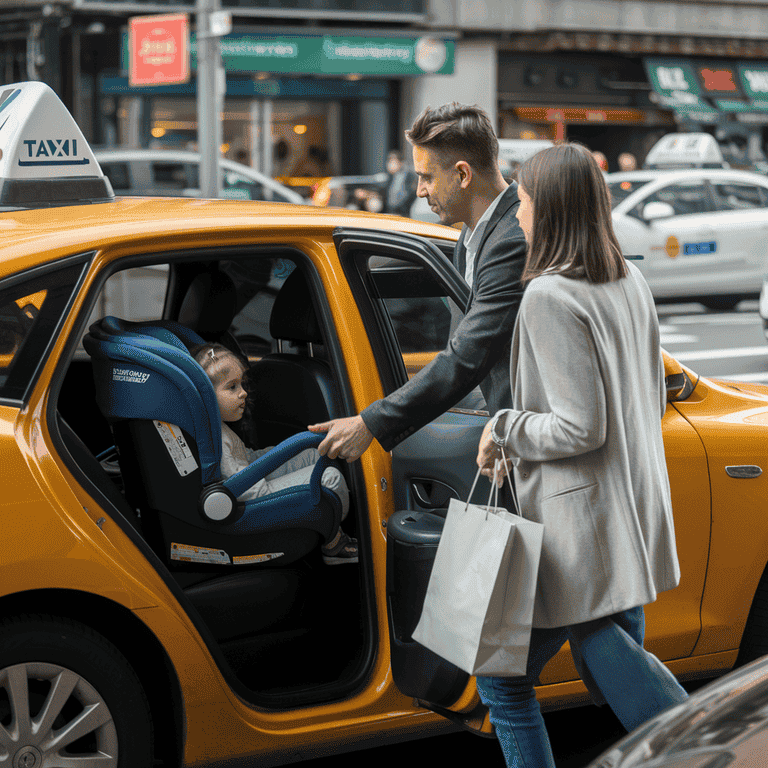
Exceptions to Nevada Car Seat Laws
While Nevada’s car seat laws are strict, a few exceptions exist. These exceptions don’t apply to most families but are important to be aware of if you are in a unique situation.
Situations Where Car Seat Laws May Not Apply
Nevada allows for certain exemptions under specific circumstances. Knowing when these apply is essential to ensuring your child’s safety, even if the law doesn’t require a car seat.
Medical Exemptions
- If a child has a medical condition that prevents them from using a standard car seat, they may qualify for an exemption.
- To obtain a medical exemption, parents must have documentation from a healthcare provider that explains why the child cannot safely use a car seat.
- Even if your child qualifies for a medical exemption, it’s recommended to use alternative safety devices when possible.
Taxi and Rideshare Exemptions
- Nevada law does not require taxis or rideshare services, like Uber and Lyft, to provide car seats.
- Parents should always bring their car seat when using these services to ensure their child’s safety.
Are You Still Responsible?
Even with these exemptions, your responsibility as a parent or caregiver is to ensure your child’s safety. For example, just because taxis aren’t required to provide car seats doesn’t mean you should skip it. Safety always comes first, no matter the situation.
Tips for Choosing the Right Car Seat
Navigating the world of car seats can be overwhelming. With so many options and safety features, knowing which is best for your child can be difficult. Don’t worry—we’ve got you covered.
How to Select a Car Seat Based on Your Child’s Age, Weight, and Height
Different car seats are designed for various stages of your child’s growth. To make sure you’re choosing the right one, keep these guidelines in mind:
- Infants: Rear-facing car seat (usually up to 20 lbs or one year old).
- Toddlers: Forward-facing car seat (usually 20-40 lbs or 1-4 years old).
- Older children: Booster seat (typically 40-100 lbs and 4-8 years old).
Always check the manufacturer’s guidelines for the car seat you’re considering.
Factors to Consider When Purchasing a Car Seat
Once you know which type of car seat your child needs, it’s time to narrow down your options. Here are some essential factors to think about:
Safety Ratings
- Look for car seats that have been crash-tested and meet federal safety standards.
- Read reviews and ratings from trusted sources like the National Highway Traffic Safety Administration (NHTSA).
Expiration Dates
- Car seats expire, typically 6-10 years after manufacture.
- Check the expiration date before purchasing, especially if you’re buying secondhand. Expired car seats may not meet current safety standards.
Ease of Installation
- Choose a car seat that is easy to install correctly in your vehicle. Some models are more user-friendly than others.
- Consider seats with LATCH systems (Lower Anchors and Tethers for Children) for easier installation.
Comfort for Your Child
- Look for car seats with cushioned seats, adjustable headrests, and straps to ensure comfort, especially for long car rides.
- Some seats have extra features like cup holders or reclining options, making traveling more enjoyable for your child.
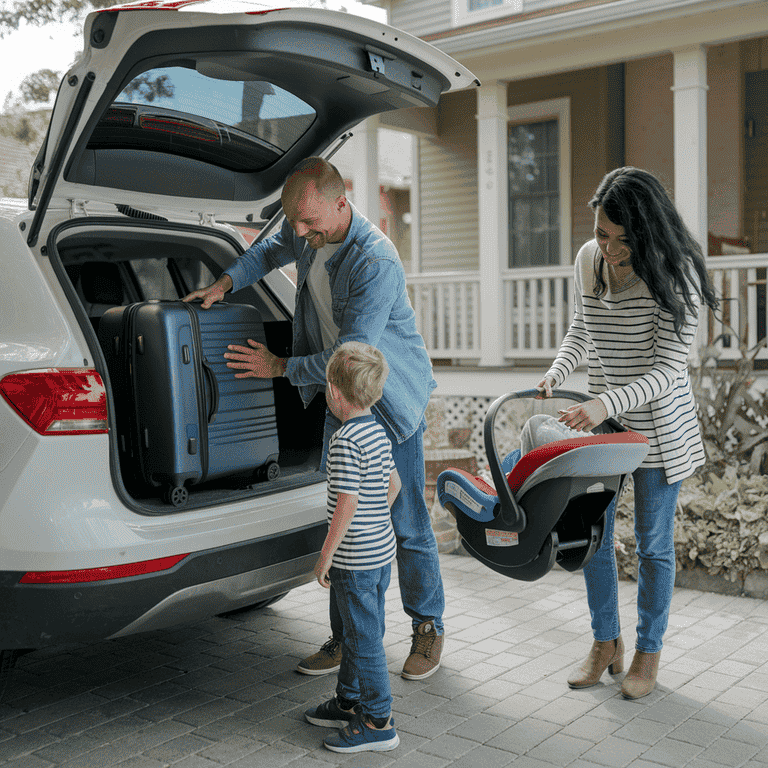
Traveling in Nevada with Children: Car Seat Safety Tips
Traveling with children can be stressful, but ensuring they’re in the right car seat can give you peace of mind. Whether driving across town or taking a road trip, following these tips will help keep your little ones safe.
Traveling Within the State and Across State Lines
Following the state’s car seat laws is essential when driving in Nevada. However, if you plan on traveling out of state, be aware that car seat laws can vary from state to state.
Nevada Car Seat Laws vs. Other States
- Nevada law: Requires children under six years old and weighing less than 60 lbs to be in a car seat.
- Other states: Some states may have stricter or more lenient rules. Always check the laws of the state you’re visiting to stay compliant and ensure your child’s safety.
Sticking to Nevada’s guidelines is best even if other states have looser requirements, as it prioritizes your child’s safety.
Car Seat Safety for Long Trips
Long road trips can be harsh on both kids and parents, but here are a few tips to make sure your child stays safe and comfortable:
- Check car seat installation: Double-check that the car seat is installed correctly before you hit the road. This is especially important if you’ve recently removed or adjusted the seat.
- Take breaks: Plan regular stops so your child can stretch and move around. This also allows you to check the car seat and ensure your child is still safely secured.
- Pack essentials: Bring toys, snacks, and drinks to entertain your child. A happy child is much less likely to try and wiggle out of their seatbelt.
These tips will help make your trip more enjoyable and keep your child safe, no matter how far you travel.
How to Ensure Compliance with Nevada’s Car Seat Laws
Understanding Nevada’s car seat laws is one thing, but ensuring you comply with them can be a different challenge. Here’s how to stay on top of things and keep your child safe.
Double-Checking Car Seat Compliance
It’s always a good idea to review the car seat regulations now and then, especially as your child grows. A quick check can help ensure you’re still following the rules:
- Has your child outgrown their current seat? If so, it’s time to move to the next type (rear-facing, forward-facing, or booster).
- Is the seat installed correctly? A poorly installed car seat won’t protect your child in a crash.
- Are the harness and straps adequately adjusted? They should fit snugly around your child without being too loose.
Keeping Up with Any Changes in Nevada Car Seat Laws
Car seat laws can change over time, so staying informed is essential. Some ways to keep up with changes include:
- I am signing up for updates from Nevada’s Department of Motor Vehicles (DMV) or local safety organizations.
- They are attending community events on child safety, where professionals often provide updates on the latest laws and best practices.
Educational Resources for Parents
Nevada offers several resources to help parents understand and comply with car seat laws. Here are a few you can check out:
- Nevada DMV website: Regularly updates car seat laws and provides links to certified inspection locations.
- Safe Kids Nevada: Offers car seat safety education, including installation tips and inspection events.
- Hospitals and pediatricians Often provide materials and classes on car seat safety for new parents.
By staying informed and using available resources, you’ll ensure your child remains safe and protected while you’re on the road.

Breaking It All Down
In Nevada, following car seat laws isn’t just about obeying the rules—it’s about keeping your child as safe as possible whenever they’re in the car. Understanding when to use a rear-facing seat, when to switch to a booster, and how to install them correctly can make all the difference in protecting your child in an accident.
You can know your child is secure by staying informed about Nevada’s car seat laws, keeping up with the right seat for your child’s size and age, and taking advantage of free inspection services. Even though the statutes seem complicated, breaking them down into easy-to-follow steps simplifies the process.
Remember, your child depends on you to make the right choices for their safety—whether you’re driving across town or heading out on a long road trip. Keeping their safety in mind and following Nevada’s laws will ensure your little one stays as protected as possible.
As always, if you’re unsure or need help, take advantage of the great resources available throughout Nevada. From free car seat inspections to safety guides, there’s plenty of support to ensure you’re doing everything right.
Drive safely and confidently, knowing your child is as protected as possible!

Frequently Asked Questions
What happens if my child outgrows their car seat before they are old enough for a booster seat?
If your child has outgrown their forward-facing car seat but isn’t ready for a booster seat yet, it’s essential to check the weight and height limits of the seat. Some forward-facing seats are designed to accommodate larger children up to 65 pounds. Ensure your child remains in a seat that fits their size, even if they still need to meet the age requirement for a booster seat.
Can I use a second-hand car seat for my child?
Yes, you can use a second-hand car seat, but there are a few things to remember. Ensure the seat has never been in a car accident, as this can weaken its safety. Also, check that it hasn’t expired and hasn’t been recalled. Finally, confirm that all parts are present, including the instruction manual, and that the seat fits your child’s current age, height, and weight requirements.
Can my child sit in the front seat if they are in a booster seat?
It’s generally safer for children to ride in the back seat until they are at least 13. Airbags in the front seat can pose a significant danger to children, especially those in booster seats. Nevada law doesn’t expressly prohibit booster seats in the front, but it’s recommended that all young passengers stay in the back for maximum safety.
Are there any specific recommendations for car seat safety during extreme heat in Nevada?
Yes, Nevada’s hot climate can make car seats very hot, which can cause burns to your child’s skin. To avoid this, cover the car seat with a towel or sunshade when the car is parked, and check the seat’s temperature before placing your child in it. Additionally, never leave your child in the vehicle unattended, as the inside of a car can reach dangerous temperatures quickly.
How often should I check that my child’s car seat is installed correctly?
It’s a good habit to check the car seat’s installation regularly, especially after long trips, cleaning, or if the seat has been removed. Even if the seat looks fine, minor adjustments may be needed to ensure it remains tightly secured. A monthly check should be enough for most families.
Can my child use a car seat designed for an airplane in my car?
Yes, many car seats approved for airplane use can also be used in cars. These seats typically meet the Federal Aviation Administration (FAA) safety standards and can be installed like any other car seat in your vehicle. Check the seat’s label for compatibility with both cars and airplanes.
Do I need a car seat for a short taxi or rideshare trip?
Yes, even for short trips, your child should be in a car seat to ensure their safety. Nevada law does not require taxis or rideshares to provide car seats, so it’s your responsibility as a parent to bring one. Many portable car seats and boosters are available for easy transport.
Can I use a European or international car seat in Nevada?
Car seats used in Nevada must meet U.S. federal safety standards, which are indicated by labels showing the seat is approved by the National Highway Traffic Safety Administration (NHTSA). European or international seats may need to meet these standards and could be illegal in Nevada. Always check the labels to ensure the seat complies with U.S. regulations.
What should I do if my child unbuckles themselves while I’m driving?
If your child can unbuckle their seatbelt or harness, pull over safely and buckle them immediately. Explain to your child the importance of staying buckled for their safety. You can also look into purchasing products to prevent children from unbuckling their restraints.
Are there specific Nevada laws about using car seats in pickup trucks?
The same car seat laws apply to driving a sedan, SUV, or pickup truck. If your pickup truck only has a front seat, Nevada law recommends placing the child in the center seat and turning off the airbag if possible. However, it’s generally safer for children to ride in the back seat, so if your truck has a back seat, use it for car seat installation.
What if I’m renting a car in Nevada and don’t have a car seat with me?
Most rental car companies offer car seats as an add-on option. Request one in advance and check that it is appropriate for your child’s age and size. If you’re traveling by plane, some airlines also allow you to bring your car seat for rental car use.
Is there a difference between car seat laws for private vehicles and public transportation?
Yes, Nevada’s car seat laws primarily apply to private vehicles. Public transportation, including buses and trains, usually doesn’t require car seats. However, if you’re using a taxi or rideshare service, you are still responsible for securing your child in a car seat, as those services don’t typically provide one.

Glossary
Booster Seat: A type of car seat used for older children who have outgrown their forward-facing seats. Booster seats help position the seat belt correctly across the child’s body, providing additional safety.
Car Seat: A portable seat designed for infants and small children, which attaches to a vehicle’s seat using the seatbelt or LATCH system to keep children safe in case of an accident.
Defensive Driving Class: A course that teaches driving techniques to help prevent accidents and maintain control in hazardous conditions. In some cases, attending this class can reduce penalties for car seat law violations.
Expiration Date (Car Seats): The date after which a car seat is no longer considered safe to use, usually due to wear and tear or outdated safety standards. Car seats typically expire 6-10 years after manufacture.
Forward-Facing Car Seat: A car seat designed for toddlers and young children, allowing them to face the front of the vehicle. These seats often have a 5-point harness for added safety and are used once a child outgrows the rear-facing seat.
Harness System: The safety straps in a car seat that secure a child by connecting over the shoulders, hips, and between the legs. A 5-point harness is considered the safest system for young children.
High-Back Booster Seat: A booster seat that includes back and head support, ideal for cars without high seat backs. It helps ensure that the seat belt fits correctly on a child’s body.
LATCH System: Stands for Lower Anchors and Tethers for Children, a system that makes it easier to install car seats without using seat belts. It involves built-in anchors in the car and tethers on the car seat.
Medical Exemption: A legal exemption from car seat laws due to a child’s medical condition that prevents them from safely using a standard car seat. Requires documentation from a healthcare provider.
National Highway Traffic Safety Administration (NHTSA): A government agency responsible for setting safety standards for vehicles and car seats. They conduct crash tests and provide safety ratings for car seats.
Rear-Facing Car Seat: A car seat designed for infants and young toddlers, facing the back of the car to better protect a child’s head, neck, and spine in a crash.
Rideshare Service: Transportation services like Uber or Lyft, which connect passengers with drivers through an app. In Nevada, these services are not required to provide car seats, so parents need to bring their own.
Seat Belt Fit Test: A test to determine if a child is ready to use a seat belt without a booster seat. It checks if the lap and shoulder belts fit properly and if the child’s knees bend at the seat’s edge.
Shoulder Belt: The part of the seat belt that crosses over the shoulder and chest of a passenger. For children, it must sit properly across their body to provide adequate protection.
Tether Anchor: A hook in the vehicle that attaches to the tether strap on a forward-facing car seat to prevent the seat from tipping forward in a crash.
Tether Strap: A strap that connects the top of a forward-facing car seat to the tether anchor in the vehicle. It helps stabilize the car seat and increases safety in a crash.
Taxi Exemption: A specific situation in Nevada where taxis are not required to provide car seats for young passengers. However, it is still the responsibility of the parent or caregiver to ensure their child is in a car seat.

Additional Resources for You
Our lead attorney, Molly Rosenblum Allen, Esq., has created several resources for those in need of legal assistance. Here’s a straightforward guide to what we offer:
Las Vegas Personal Injury Attorney: If you’ve been injured due to someone else’s negligence, learn how we can help you secure the compensation you deserve. Explore more.
Las Vegas Car Accident Attorney: Car accidents can have devastating consequences. Find out how we assist victims in navigating the legal process. Learn more.
Motorcycle Accident Lawyer Las Vegas: Motorcyclists face unique dangers on the road. Discover how we advocate for riders’ rights and recovery. Read more.
Wrongful Death Lawyer Las Vegas: Losing a loved one is incredibly painful, especially if it was due to negligence. See how we can help you seek justice. Find out more.
Truck Accident Attorney Las Vegas: Truck accidents often result in serious injuries. Get information on how we support victims through legal challenges. Check here.
Las Vegas Drunk Driving Accident Attorney: Drunk driving accidents are preventable tragedies. Learn about the support and representation we offer. Visit this link.
Las Vegas Slip and Fall Attorney: Slip and fall accidents can occur anywhere, often due to negligence. Understand how we assist in these cases. Click here.

Outside Resources for You
National Highway Traffic Safety Administration (NHTSA): A key resource for information on vehicle safety, including car seats and road safety guidelines. Visit NHTSA.
American Association for Justice: An organization that promotes fairness and justice through the legal system, focusing on protecting the rights of those injured by negligence or misconduct. Explore AAJ.
American Bar Association: Offers resources for the public, including legal guides and information on finding legal assistance. Check out ABA.
Safe Kids Worldwide: Dedicated to preventing injuries in children, this organization provides resources on child safety, including car seat safety tips. Discover Safe Kids Worldwide.
Insurance Institute for Highway Safety (IIHS): Provides ratings for vehicle safety and evaluations of car seats for crash protection and ease of use. Learn more at IIHS.
Consumer Reports: Offers buying guides, product reviews, and ratings, including evaluations of car seats and tips for child safety. Visit Consumer Reports.
National Safety Council: A nonprofit organization focused on promoting health and safety at home, in vehicles, and in the workplace. Explore NSC.

A Special Message from Our Lead Attorney, Molly Rosenblum Allen, Esq

Dear Readers,
Thank you for taking the time to explore the resources we’ve provided. We understand that dealing with legal challenges can be overwhelming, and it’s our mission to offer guidance and support through every step of your journey. Your well-being and peace of mind are our top priorities.
If you need further assistance or have questions about your situation, please don’t hesitate to contact me and my team at The Rosenblum Allen Law Firm. You can contact us at (702) 433-2889 to discuss how we can assist you in moving forward with your case.
Warmest regards,
Molly Rosenblum Allen, Esq.

